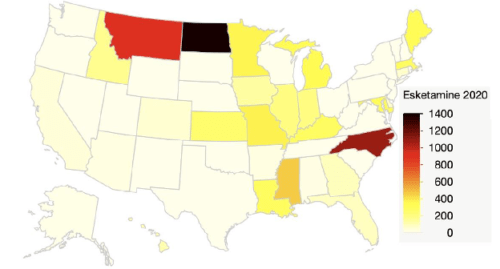
05 Mar Ten states including New York and Texas Prescribed no Esketamine or Ketamine to Medicaid patients
Editor’s note: This piece discusses suicide. If you have experienced suicidal thoughts or have lost someone to suicide and want to seek help, you can contact the Crisis Text Line by texting “START” to 741-741 or call the Suicide Prevention Lifeline at 800-273-8255.
MedicalResearch.com Interview with:

Alexia Aguilar
Alexia Aguilar
Geisinger Commonwealth School of Medicine
Scranton, PA
MedicalResearch.com: What is the background for this study?
Response: Traditional antidepressants like Zoloft and Lexapro have three major drawbacks.
- First, they have a therapeutic lag and take at least a couple weeks to begin to improve mood.
- Second, they do not work very well for many patients with only about one-third experiencing a remission.1
- Third, they carry a Food and Drug Administration black box warning for increasing the risk of suicide in young-adults.
There is tremendous enthusiasm for the anesthetic ketamine and esketamine because they overcome all three of these limitations.
The brand name of esketamine is Spravato. Spravato received conditional approval from the FDA in March of 2019 as a nasal spray for treatment resistant depression or acute suicidality. The goal of this study was to examine prescriptions for ketamine and esketamine in 2019 and 2020.
MedicalResearch.com: What are the main findings?
Response: There are two key findings.2
- First, was the increase in esketamine relative to ketamine prescribing rates. After its approval in 2019, esketamine prescriptions increased 121.3% in 2020 and prescriptions were double those of ketamine.
- Second, there was substantial state-level variability in prescribing rates. For example, in 2019 Indiana prescribed 25% of the national total esketamine. In 2020, there was a 245-fold difference between the highest and lowest prescribing states . Twenty-one states in 2019 and 10 states in 2020 (including New York, Oklahoma, Rhode Island, South Carolina, Texas, Virginia, Vermont, West Virginia, Wisconsin, & Wyoming) neither prescribed ketamine nor esketamine.
MedicalResearch.com: What should readers take away from your report?
Response: The identification of the rapid therapeutic and anti-suicidality effects of ketamine and esketamine is one of the most important developments in psychopharmacology in the past two decades. Suicide is often one of the top 10 causes of death in the U.S., particularly among young-adults.3 Yet, we found that use among Medicaid patients was both modest, relative to the prevalence of depression and treatment resistant depression, and extremely variable. Prescription rate are nowhere near as high as one might expect from an antidepressant which overcomes the therapeutic lag of other antidepressants. We are underutilizing medications that have the ability to significantly decrease the ever-growing suicide rate in the United States.
MedicalResearch.com: What recommendations do you have for future research as a result of this study?
Response: Future studies should analyze marketing of esketamine, perception of use of ketamine and esketamine, or other possible reasons for underutilization and these geographical variations. A cost analysis of intravenous ketamine or nasal esketamine assisted psychotherapy versus prescribing a pill form of antidepressant should be completed to provide a more robust understanding of ketamine/esketamine’s potential value.
Esketamine costs about 30-fold more than ketamine. There are also some indications from both basic science research and clinical trials that generic intravenous ketamine is more effective than brand name intranasal esketamine in treating depression.4 Further study to develop more effective interventions for treatment resistant depression is needed.

Prescriptions for esketamine (Spravato) per one-million Medicaid enrollees.
Figure. Prescriptions for esketamine (Spravato) per one-million Medicaid enrollees.
Citations
- Howland. Sequenced treatment alternatives to relieve depression (STAR*D). Part 2: Study outcomes. Journal of Psychosocial Nursing & Mental Health Services 2008; 46 (10):21–24.
- Aguilar et al. Pronounced regional variation in esketamine and ketamine prescribing to US Medicaid patients. Journal of Psychoactive Drugs, https://pubmed.ncbi.nlm.nih.gov/36857284/
- Heron M. Deaths: Leading Causes for 2019. National Vital Statistics Reports. 70(9): 1-144.
- Bahji et al. Comparative efficacy of racemic ketamine and esketamine for depression: a systematic review and meta-analysis. Journal of Affective Disorders. 2021; 278: 542–555.
Editor’s note: This piece discusses suicide. If you have experienced suicidal thoughts or have lost someone to suicide and want to seek help, you can contact the Crisis Text Line by texting “START” to 741-741 or call the Suicide Prevention Lifeline at 800-273-8255.
Last Updated on March 5, 2023 by Marie Benz
